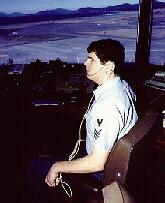 Naval Aviation
requires adequate airspace and ranges to practice tactics, perform research
and development, to train realistically (i.e., to train as we will fight),
and to transit aircraft from airfields to ranges. The Federal Aviation
Administration (FAA) recently introduced the concept of Free Flight, which
empowers the pilot to choose where the aircraft will fly based on the most
economic route. Because of the Free Flight concept, we will be under increased
pressure to allow civilian access to military special-use airspace.
Naval Aviation
requires adequate airspace and ranges to practice tactics, perform research
and development, to train realistically (i.e., to train as we will fight),
and to transit aircraft from airfields to ranges. The Federal Aviation
Administration (FAA) recently introduced the concept of Free Flight, which
empowers the pilot to choose where the aircraft will fly based on the most
economic route. Because of the Free Flight concept, we will be under increased
pressure to allow civilian access to military special-use airspace.
To ensure we retain the special use airspace we need, the Department
of the Navy and the Department of Defense are investing in a Military Airspace
Management System that will closely track the utilization of special use-airspace,
documenting who uses it, and why. Additionally, air traffic control (ATC)
equipment located at NAS and Marine Corps Air Station (MCAS) approach controls
is being upgraded in coordination with the FAA to ensure that naval aircraft
are handled as efficiently and expeditiously as civilian aircraft. Naval
Aviation is involved with the other services to define the next generation
Joint Precision approach capability and to determine the timing of upgrades
to aircraft avionics which will ensure our continued access to airspace
worldwide.